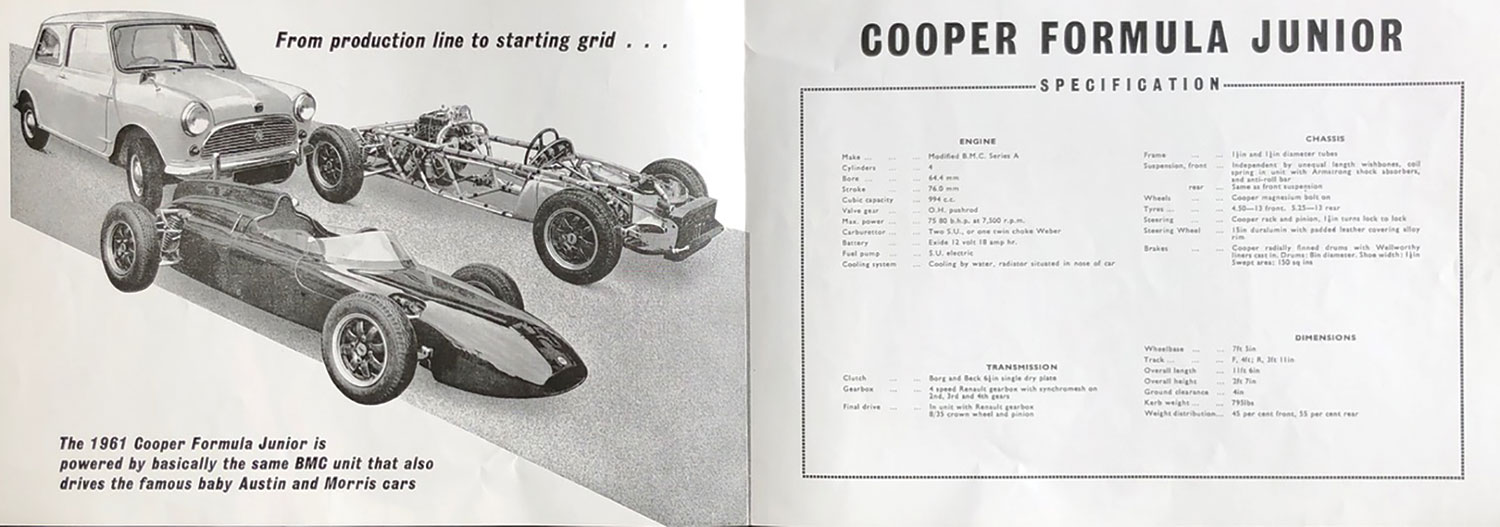|
May/June 2019 edition Issue #5 AutoMobilia Resource Magazine David Kayser In the 1950s, sports car racing experienced significant popularity all across the country as it was the most affordable way for most amateur race enthusiasts to enjoy competitive motorsports. However, the amateur racer faced limited choices if he or she was ready to advance and experience the excitement of a true purpose-built, open-wheel, single-seat race car. To address this void and create an affordable alternative, the FIA created “Formula Junior” class of open wheel racing cars, designed to allow chassis constructors to utilize readily available existing mass-produced components, such as engines, transmissions, and brakes. These various “FJ” builders were small companies who often advertised with tiny ads in the back pages of sports car and specialist racing magazines. The manufacturers would encourage a prospective customer to write directly to the “factory” for more information. Being so small, they could not be expected to produce extravagant promotional material and sales brochures. What they offered was crude and almost invariably printed in black and white, on cheap thin paper. Lotus sold their Formula Junior (Lotus 18) in the US through its notoriously poorly supported USA distribution arrangement with several “exclusive” East coast and West coast dealers, who usually found sales literature from England virtually impossible to procure, causing them to scramble together some simple flyers. Several Italian constructors including Taraschi, Bandini, and Volpini were represented in the USA by Biener Motors, a New York area Pontiac dealer, who printed their own sales literature utilizing parts of the original Italian market brochure, along with their own descriptive text in a paste-up, especially for USA market customers. These brochures were printed in very limited batches even by the standards of their time. Values today range between $50-$150 depending on the usual factors of rarity and condition. Let’s take a look at some these the brochures. You won’t find any clever “Mad Men” inspired copy, or detect the work of an adventurously creative art director here. These were racing cars aimed at a specialist market of knowledgeable customers, just presenting specs, data, and a few photos in a simple direct manor with a minimum of hype. Original race car sales brochures are among the most challenging examples of collectible automobile literature to find. Obviously, the original market for these cars was small even in period, and the marketing budgets of the overwhelming majority of these companies was minimal. The challenge for the serious collector or racing historian becomes sourcing what remains 60 years later. Values of these brochures is often directly related to the relative successes the car or constructor had when the cars were new, as well as their current representation at vintage races today. Therefore, Lotus brochures are valued more than say a Dane brochure; the halo and legacy of Lotus race history is more significant. Specialist automobile literature, or automobilia dealers who generally deal in racing ephemera, would probably be the best place to start your search. Additionally, check out the various auction houses both internationally, and regionally, that have regularly scheduled auction sales where some of the most obscure and desirable material regularly surfaces… though the bidding often becomes intense for the very best items. As always, maintaining a standing search on eBay occasionally results in finding that elusive bargain.  Yimkin – 4-page brochure: This folder from a UK constructor makes a case for considering a Yimkin because of its ease of care and outstanding reliability. An unusual pitch for a racing car! This innovative, relatively affordable, yet very sophisticated formula class, was responsible for jump starting the careers of a multitude of talented drivers into the early 1960s. The very rare surviving sales brochures saved in the archives of collectors of historic racing literature, often serve as a fascinating historical document in this important era of racing, as well as an often, invaluable resource for current owners dedicated to achieving period correct restorations. David Kayser To read more great columns like this one from automotive literature expert David Kayser... |
Motoring LiteratureDavid Kayser, owner of Chelsea Motoring Literature, specializing in postwar European special interest sales literature and shares that information with you here. Archives
August 2019
Categories
All
|
Home
|
Subscribe
|
|
Automobilia Resource LLC
1217 Cape Coral Pkwy East #178 Cape Coral, Florida 33904 Main office: 954-579-5280 Subscriptions: 224-558-8955 Editor: 631-258-9887 |
Copyright © 2023 Automobilia Resource LLC. All Rights Reserved






 RSS Feed
RSS Feed